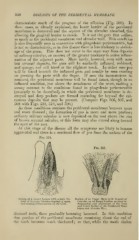Page 950 - My FlipBook
P. 950
960 DISEASES OF THE PERIDENTAL MEMBRANE. ;
characteristic mark of the progress of the aifection (Fig. 509). In
these cases, as already explained, the lower border of the peridental
membrane is destroyed and the septum of the alveolus absorbed, this
allov.ing the gingival border to recede. It is not the gum that suffers,
so much as the peridental membrane and alveolar wall. This condition
is also frequently seen in connection with phagedenic pericementitis, but
is not so characteristic, as in this disease there is less tendency to shrink-
age of the gums. This does not occur in the same way from deposits
of salivary calculus, on account of the greater tendency to active inflam-
mation of the adjacent parts. More rarely, however, even with none
but serumal deposits, the gum will be markedly inflamed, reddened,
and spongy, and will bleed at the slightest touch. In either case pus
will be found beneath the inflamed gum and usually be seen exuding
on pressing the parts with the finger. If now the incrustations be
removed, the peridental membrane will be found intact, though in an
inflamed condition, just above the attachment of the crust, making a
strong contrast to the conditions found in phagedenic pericementitis
(presently to be described), in which the peridental membrane is de-
stroyed and deep pockets are formed extending far beyond the cal-
careous deposits that may be present. (Compare Figs. 506, 507, and
508 with Figs. 518, 519, and 520.)
As these conditions continue the peridental membrane becomes more
and more diseased ; the formation of pus is more and more profuse
ordinary salivary calculus is now deposited on the root above the rim
of brown serumal calculus, or this form may also extend along to^\ard
the apex of the root.
At this stage of the disease all the symptoms are likely to become
aggravated and there is a continual flow of pus from the sockets of the
Fig. 510.
Fig. 511.
Section of a Lower Incisor with a large De- Section of an Upper Molar with Deposit of
posit of Salivary Calculus impinging upon, Calculus on its Buccal Surface causing In-
and causing Inflammation of, the Gum. flammation and Absorption of the Gum
and Lower Border of the Peridental Mem-
brane and Alveolar Wall.
diseased teeth, these gradually becoming loosened. In this condition
that portion of the ])eridentnl membrane remaining about the end of
the tooth becomes much thickened ; so that, while the tooth shakes


